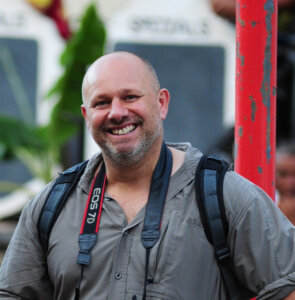 David Higgins works in conservation. He has lived and worked in the Falkland Islands, St Helena Island, India, The Skerries, the Yorkshire Dales, the North Pennines and now the Wiltshire Wildlife Trust. He loves islands especially seabird colonies, where he enjoys his main passion of wildlife photography.
David Higgins works in conservation. He has lived and worked in the Falkland Islands, St Helena Island, India, The Skerries, the Yorkshire Dales, the North Pennines and now the Wiltshire Wildlife Trust. He loves islands especially seabird colonies, where he enjoys his main passion of wildlife photography.
Filmed at 120 frames per second I may have looked graceful. The slow release of fingers from rock, the straight bodied twist. A full 180. Floating down slowly under moon strength gravity. The slight hint of becoming airborne after hitting the sea washed ledge. Waves of blubber rippling up and down my body like an Elephant Seal. In real time I hit the ledge a micro-second after my grip failed. My back smacked into rock, knocked the air from my lungs. The thing that saved me was Katy’s peat cores in the rucksack.
I’m laid on my back as waves wash over me. I try to remove the bag, but it won’t budge. The next thing Katy’s next to me, one boot on, one off. She didn’t even finish changing before leaping down the narrow rock cleft onto steep algae-slipping rock. Katy takes the rucksack giving me a chance to stand. She maintains she was there to help me, everyone else suggests she was rescuing the cores. As I climb out, I kneel in sea lion shit. It’s a marine smell that loves to linger. I introduce insult to injury, and salt to wound.
North Island is a place I yearned to visit since arriving in the Falkland Islands. A distant rock island, steep sides with a plateau fringe of Tussac Grass concealing a Bluegrass centre. It sits north of New Island in the far south-west of the Falklands, Saddle Island positioned between the two.

My project is managed by Falklands Conservation and funded by Defra’s Darwin Plus programme which enhances UK Overseas Territories understanding and management of biodiversity and climate change. The target habitats on North Island are Tussac and Bluegrass. Both are exceptional peatlands, but Tussac is the one that fascinates me.
Extensive wind-rustled stands of Tussac Grass can cover whole islands. The peat is carbon dense and up to thirteen metres deep. Above ground, living plant matter sits on packed pedestals of dead leaves. In combination, the plinths can be three metres high. The densest Tussac, that most like pristine habitat, grass blades become fixed by friction which makes walking arduous.
Tussac Grass is a habitat for Sea Lions, Prions, Petrels, Penguins, Shearwater, Albatross, Tussac Birds (Blackish Cinclodes) and endemic species like Cobb’s Wren. The soil properties give a structure burrowing birds love. Their tunnels are supported by a stable soil, layered like cakes and bound together by a string of old roots. The high pedestals create a sheltering micro-climate that dampens constant South Atlantic winds.

The grass relies on the annual influx of marine nutrients and the birds rely on it for protection and a place to nest. It’s a habitat-scale symbiosis of incredible proportions. The worlds densest carbon peatlands are Tussac habitats in the Falkland Islands. The peat can hold over 90% water meaning dead matter accumulates at several millimetres a year.

Tussac Grass is a pig to push through. The best method is to jump from pedestal to pedestal. Never let your feet touch the ground. But I’m waiting for a hip replacement and my method is to jump, fall and roll into the tight spaces between pedestals. Then regain composure, push through friction locked blades, falling as I go. Sometimes I remove the heavy rucksack, drop it on the other side and try to join it. When I was younger, I walked 45 miles in a day and could cycle over 100 miles with laden paniers. Pushing through 300m of Tussac with a gammy leg is far more exhausting.
To access North Island we travel by yacht with Hugue and Marie-Paul. Then Marilou or Theo takes our six strong team in two runs on a small tender to the base of the cliff. Once on land we take a moment to plan the route. The added hazard; it’s the same route the Southern Sea Lions take. The step-cliff is slippery from Sea Lion smoothed rocks, from soil leached water and Sea Lion muck.
When we start clambering we look out for these marine mammals that could panic right over us if disturbed. It takes fifteen minutes to reach the top, the Tussac becoming denser and denser as we go. In full Tussac we can’t see beyond a few pedestals meaning we rely on the GPS. If lost here, a short distance can quadruple as you walk in circles with no landmarks to aid the way. Quickly the group are ahead of me. I don’t like it, this is my project but I’m always behind. Thankfully, the team make allowances.
We push on towards the rookery. The group go right around a large pedestal, but it looks easier to the left, so I take that path. I’m hit by something that bites into my stomach. I only see the Sea Lion as it flubbers away at top speed. Not much blood but a large spreading bruise. I learn my lesson, never stray from the crowd.
I clean the wound but refuse to dwell, we have four large 200m2 X-plot surveys to conduct in both habitats. We need to identify plants, measure sward height, take soil depths and soil samples for bulk density, moisture, pH and carbon analysis. There are invertebrate and bird surveys to complete with the added hazard of the wildly changeable Falklands weather. Then we have to land on Saddle Island and do it all again while pushing through old-growth grass that only the maddest tackle. Each pedestal can be two hundred years old set in a habitat that’s been accumulating carbon for thousands of years.
After we survey the Tussac we move to Bluegrass. This was once the most abundant grass in the Falklands, but it’s been grazed down to severely restricted. We have to travel to high hills or offshore islands to find a mirror of the past. On islands like Motley, Flat Jason, Split and North Bluegrass still thrives forming stumbling tussocky hollows rich in ferns and flowers. The sward height can be a metre high, much less biomass than Tussac, but there are more associated species. Woolly and Smooth Ragwort, Small Fern, Tall Fern, Scurvy Grass, Orchids, Mountainberry, Teaberry, Pale Maiden, Vanilla Daisy and Falkland Rock-Cress can all thrive with Bluegrass. Then there are Black-Chinned Siskins and White-Bridled Finch, Johnny Rooks (Striated Caracara) and Magellanic Snipe. Large stands of Bluegrass give a pink hue to the landscape. It’s as stunning as it is remote.

We take soil and vegetation measurements, identify plants, suck up invertebrates with the vac sampler. While I do the bird surveys the others go to the rookery of Black-Browed Albatross, Southern Rockhopper Penguins and Imperial Shags. Being the lead has its downside.
It takes four hours to complete the surveys from landing to leaving. At the last moment my fingers give way as I scramble along a narrow shelf. It’s an uncontrolled two metre drop to where Katy leaps to my rescue. I’m soaked, clothes dripping, boots full of cold sea. I stink of Sea Lion muck. No injuries other than a diminished self-respect.
As the island reduces with distance, I smile knowing I’ll never visit again. I can forget the constant discomfort from a half-working leg, the Sea Lion hazard, the falls, the gymnast standard plummet, the knee coated in shit. But I realise how fortunate I’ve been. More people will have been to space then have landed on North Island. It’s a place rich in biomass, deep carbon-rich soil coupled with species I never thought I’d see. North Island may be my nemesis, the place where my dignity died, but it’s still an incredible natural wonder.
A short video of a dynamic team at work:
One of the final outputs from the DPLUS110 Peat-Wetlands Project was to develop a Habitat ‘scoring’ Key which can be downloaded from:
https://falklandsconservation.com/wp-content/uploads/2024/02/Field-Key-V3-Compressed.pdf
[registration_form]
Source link




